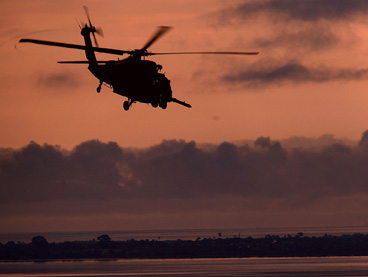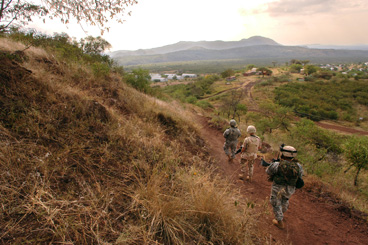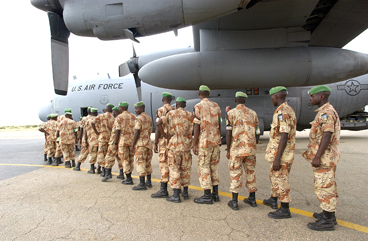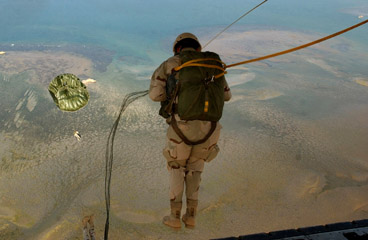Ike Skelton, the Missouri Democrat who chairs the House Armed Services Committee, is aware that Africa isn’t on anybody’s “short list” of pressing US military concerns, but he believes it could end up there, for several reasons.
First, Skelton notes, Africa “is a theater in the War on Terror,” with legions of Muslim extremists hiding out in Africa’s vast, ungoverned spaces. Next, he says, conventional wars often threaten friendly nations there. Finally, the oil that Africa supplies to the West is vulnerable to disruption.
If you combine those factors, warns Skelton, “you have the makings of some first-class security challenges.”
 |
Air Force HH-60G over West Africa. (USAF photo by TSgt. Justin D. Pyle) |
Skelton may be onto something. Washington has begun paying careful attention to what happens in the vast and complex continent of Africa, and with something other than a purely humanitarian interest.
No one is claiming Africa compares to Europe, East Asia, or the Mideast in strategic importance.
What is undeniable, though, is that Africa no longer is a strategic backwater, as it always has been. Militarily, the US is stepping up its involvement there. Moreover, Africa today is the focus of Washington’s expanding rivalry with China—a competition that influences, and is influenced by, all other challenges.
The clearest sign of change is Washington’s reorganization of its military structure.
A little history is instructive. Washington, with massive postwar obligations in East Asia, created US Pacific Command in 1947. Next came US European Command, which emerged in 1952 after the Berlin Crisis. In 1963, with Fidel Castro making trouble in Latin America, DOD stood up US Southern Command. The creation of US Central Command, covering the Mideast, occurred in 1983, after the fall of the Shah of Iran, the Soviet Union’s invasion of Afghanistan, and the Iran-Iraq War.
Then, nothing. Until last year. That’s when the Pentagon announced the establishment of US Africa Command. Plans call for AFRICOM to coordinate US activities in all African nations except for Egypt—53 countries in all. (Egypt remains in USCENTCOM.)
“The fact that Africa is rising in significance … is undeniable,” said Ryan Henry, principal undersecretary of defense for policy. “The reorganization of our military structure … is just a manifestation of that growing importance.”
The term “Africa” is mostly a geographic expression, with little else that fits a broad generalization. Africa has enormous rivers and vast deserts, soaring mountains and teeming swamps. The north is overwhelmingly Muslim, the south mostly Christian or animist.
It is a place of trackless and lawless wastelands, on one hand, and mega-cities on the other. Africans can be black, white, Asian, or Semitic. Some nations are rich (at least in resources) and many are dirt-poor. It is industrial and agricultural. There are brutal dictatorships and thriving democracies.
A Strategic Vulnerability
Of all the world’s ungoverned spaces, none are vaster or further outside the reach of law and civil authority than those in Africa. The landscape of desert, seemingly endless savannah, and marshy and overgrown delta provides valuable cover for small bands of terrorists, just as sprawling urban centers mask the operations of countless criminal gangs.
After the 9/11 terrorist attacks, US officials tasked with developing a battle plan for the Global War on Terror saw Africa as a looming strategic vulnerability. The worry was that al Qaeda, driven out of Afghanistan, would move to reconstitute its safe havens on a new continent.
 |
A1C Steven Brumley (c), a USAF radio operator, deploys with two Army Guardsmen in Southern Ethiopia. (USAF photo by MSgt. Scott Wagers) |
In truth, Africa had always played a central role in Osama bin Laden’s schemes to construct a terrorist organization capable of striking at the United States. Al Qaeda’s first attack on US forces—a failed bombing of a hotel used by US service members bound for Somalia—occurred in Africa.
Later, al Qaeda operatives helped train Somali militiamen fighting US forces. They passed along techniques for downing helicopters with rocket propelled grenades. The success of that tactic in a 1993 battle in Mogadishu—the infamous “Black Hawk Down” disaster—left 18 Army Rangers and Special Forces troops dead and led to the withdrawal of US forces from Somalia.
From 1991 through 1996, bin Laden maintained his headquarters in Africa, under the protection of Sudan’s extremist leader Hassan al-Turabi. It was here that bin Laden began in earnest to build a terrorist internationale.
Even after he was exiled to Afghanistan in 1996, bin Laden remained active in Africa. He used his long-standing connections and African cells to plan and execute the August 1998 bombings of US embassies in Kenya and Tanzania.
Africa-based al Qaeda cells mounted the 2000 attack on USS Cole in the Yemeni port of Aden. The suicide attack killed 17 sailors and nearly sank a front-line Navy warship.
It was the Sept. 11 disaster, though, that propelled US military men on serious exploratory missions in Africa.
“The 9/11 attacks were a major turning point,” said Princeton N. Lyman, former US ambassador to South Africa and Nigeria and a project director of “More Than Humanitarianism: A Strategic Approach Toward Africa,” a 2006 venture sponsored by the Council on Foreign Relations.
After the 9/11 attacks, Lyman noted, European Command officials began traveling extensively in Africa. “They saw that Africa was dangerous territory in the context of failed states and terrorism,” he said.
He went on, “There was already significant terrorist infiltration of the Sahel region and around the Horn of Africa, and great instability in the Gulf of Guinea, which is Africa’s major oil producing region.”
Subsequent events only reinforced US military apprehension.
 |
Rwandan peacekeepers board a USAF C-130 leaving the Darfur region of Sudan. (USAF photo by MSgt. David D. Underwood Jr.) |
In 2002, remnants of the al Qaeda cells responsible for those 1998 embassy bombings launched attacks in Kenya, killing 15 persons, and nearly brought down an Israeli airliner with a man-portable surface-to-air missile.
Al Qaeda recruited heavily in Africa. By one estimate, Africa supplied as much as 25 percent of the foreign fighters who joined the ranks of al Qaeda fighting US troops in Iraq.
The perpetrators of the devastating terrorist bombings in Madrid in 2004 were also aided and abetted by an Africa-based and al Qaeda-affiliated terror group in Morocco. The Salafist Group for Preaching and Combat, an Algerian band with a reputation for extreme violence, has pledged fealty to bin Laden.
The Somalia crisis that has unfolded over the past year underscores US concern about ties between failed states in Africa and Muslim terror. In 2006, an alliance of Islamic clerics and clan leaders—the Union of Islamic Courts—took over Mogadishu and imposed Islamic law there. US intelligence said the UIC included several al Qaeda-linked terrorists connected to the 1998 embassy bombings and the 2002 attacks in Kenya.
The US quietly backed intervention of Ethiopian troops to counter the Islamic forces. According to a recent Time magazine, US officials confirmed that USAF AC-130 gunships launched two attacks on convoys carrying al Qaeda-affiliated terrorists, possibly killing the man who served as bomb-maker for the 1998 embassy attacks.
Bare-Bones Facilities
The Pentagon has modestly increased its presence on the continent, and significantly stepped up its activity.
In 2002, Central Command established the Combined Joint Task Force Horn of Africa, based in Djibouti. The task force’s complement of 1,200 to 1,800 troops conduct long-range interdiction operations, train foreign military forces, and perform outreach activities in local communities. It is the biggest concentration of uniformed Americans on the continent.
According to a recent report of the Congressional Research Service, the Pentagon can count on access, as needed, to various African air bases, ports, and “bare-bones” facilities maintained by local forces in Gabon, Kenya, Mali, Morocco, Namibia, Sao Tome and Principe, Senegal, Tunisia, Uganda, and Zambia.
A US-East Africa counterterrorism initiative, launched in 2003, is distributing $100 million to upgrade the capabilities of security forces in Ethiopia and Kenya. EUCOM also began building forward operating locations—with upgraded ports and airfields and pre-positioned fuel and critical supplies at several sites.
US operations were upgraded in 2005 with the Trans-Saharan Counterterrorism Initiative, an ambitious five-year, $500 million program to improve local security capabilities in Saharan and sub-Saharan nations. The initiative’s coming out party was a 2005 regional exercise dubbed Flintlock, which featured 1,000 special operations forces.
“Past activities have made visible and measurable differences on the ground through professionalization of military units,” said Army Gen. William E. Ward, commander of AFRICOM, in recent Congressional testimony.
Apart from concerns about terrorist infestations in Africa, the US is also worried about the security of African oil.
In 2003, for example, bin Laden urged followers in Africa to open a terror front in Nigeria, a country with enormous oil reserves. In 2004, moreover, Nigerian warlord Alhaji Dokubo-Asari drove world oil prices skyward with his threats to target and kill foreign oil workers there.
 |
A USAF pararescueman jumps from an HC-130 during a training mission over Africa. (USAF photo by 2nd Lt. Shannon Collins) |
Africa today supplies 15 percent of US oil imports; in some projections, Africa would rival the Middle East—at about 25 percent—within a decade. Meanwhile, Africa has been providing China roughly a quarter of its oil imports.
Oil and Global Repercussions
EUCOM has begun a multilateral initiative called the Africa Partnership Station to increase US naval presence in the energy-rich Gulf of Guinea, an area thick with terrorists, drug runners, pirates, and oil thieves.
Still, the question of oil is sensitive, awakening old memories of Western colonialism and oil “concessions” worked out with the aid of corrupt local leaders.
As Skelton put it, “We often don’t want to overtly link our national security to the flow of that resource,” but “instability in the region not only threatens the region’s economic development, but has global repercussions as well.”
Two well-known oil producers are Arab states of North Africa—Libya and Algeria. Both are members of the Organization of the Petroleum Exporting Countries, the world oil cartel.
Even in sub-Saharan Africa, however, several nations in recent years have become important oil exporters. The biggest of these, according to a recent report of the Council on Foreign Relations, are as follows:
- Nigeria, the largest producer in Africa and also an OPEC member, has major clients in Western Europe and the US and pumps some 2.5 million barrels per day.
- Angola, another OPEC state and second to Nigeria, expects this year to produce upward of two million barrels of crude per day. It also has major offshore reserves of natural gas.
- Sudan, which daily pumps about 500,000 barrels of a light, easily refined crude, despite severe internal unrest.
- Equatorial Guinea is a niche producer of some 350,000 barrels per day, though proven reserves are estimated at about 1.28 billion barrels.
- Gabon, at 230,000 barrels per day, actually is producing less than it has in recent years, but has decent reserves.
- Republic of Congo, which averages production of roughly 235,000 barrels per day.
It is in Africa that the world most clearly sees China’s hunger for oil to fuel its decades-long economic boom.
Beijing for years now has been aggressively courting oil producers and buying up supplies, all of which has tightened the world market and increasingly pitted Washington and Beijing against each other.
China raised world eyebrows in 2006 when it hosted the largest-ever Sino-African summit in Beijing. The outreach signified the culmination of Beijing’s oil-centered diplomacy.
 |
Airmen unload an HH-60G Pave Hawk helicopter from a C-5 that has just arrived in Sierra Leone. (USAF photo by TSgt. Justin D. Pyle) |
China’s “come on” is deceptively simple, and it has proved effective with some of Africa’s most despotic regimes: “We have money and an inexhaustible market, and we don’t ask questions.” Or, as China’s then-Deputy Foreign Minister Zhou Wenzhong told one interviewer: “Business is business. We try to separate politics from business. … You [the West] have tried to impose market economy and multiparty democracy on these countries which are not ready for it. We are also against all embargoes, which you have tried to use against us.”
When Western governments tried to pressure Angola on some sensitive political issues, China stepped in with a $2 billion loan that eased that country’s isolation.
Despite the ruthless suppression of political opponents by Zimbabwe’s Robert Mugabe, who has driven his country to the brink of collapse, China has continued investing in Zimbabwe’s roads, minerals, and farming. China has also supplied Mugabe’s thuggish military with jet aircraft and other armaments.
A Many-Pronged Effort
Washington has pressured oil companies to stop doing business with Sudan because of that country’s ties to terrorism and Khartoum’s ruthless tactics against its own people in Darfur and in its earlier war against the south of Sudan. China predictably has stepped into the void. Its National Petroleum Corp. bought a 40 percent stake in Sudan oil fields and helped build a 930-mile-long pipeline, sending 10,000 Chinese laborers to work in Sudan on these projects.
US officials expect such economic and political competition in Africa to be a major feature of the Beijing-Washington relationship for years to come.
The devastation the HIV/AIDS epidemic has inflicted on Africa is also widely seen as a test case for the ability of the international community to respond to a global pandemic. In 2000, the US brought the HIV/AIDS issue to the UN Security Council, which, for the first time, recognized a health issue as a threat to international peace and security. In 2003, President Bush pledged to provide $15 billion over five years to address the AIDS disaster.
 |
USAF MSgt. Chad Bohren, Combined Joint Task Force-Horn of Africa, communicates with sentries monitoring a bombing range off the coast of Djibouti. (USN photo by Mass Comm. Spec. 1st Class Michael R. McCormick) |
These factors will force the United States to develop a sophisticated strategy toward Africa that combines all elements of US power. While the primary goal of the Trans-Sahara Initiative has been to improve the ability of local security forces to patrol borders and interdict terrorists, for instance, it also includes significant funds for public diplomacy, law enforcement, and economic assistance. In fact, officials say that not more than 20 to 30 percent of the initiative funds are devoted to military-to-military activities.
“Military assistance is an important part [of what we do in Africa], but only a very small fraction of the kinds of assistance that we provide [through] our foreign assistance budget,” Stephen D. Mull, acting assistant secretary of state for political-military affairs, said in recent Congressional testimony.
President Bush made that same point in November when he announced he would visit sub-Saharan Africa in 2008. “The new relationships that America has forged in Africa are a high priority for our nation,” Bush said.
Or, as Skelton noted, “There are places in the world beyond Iraq and Afghanistan with which we need to be concerned.”
James Kitfield is the defense correspondent for National Journal in Washington, D.C. His most recent article for Air Force Magazine, “A Czar in the Making,” appeared in the December 2007 issue.

